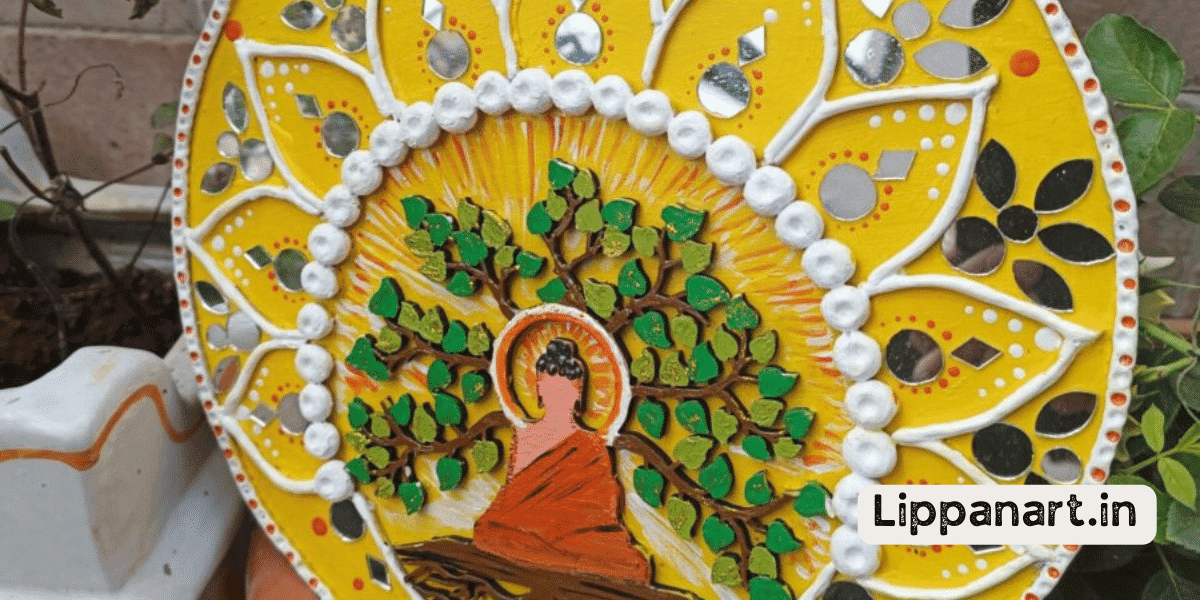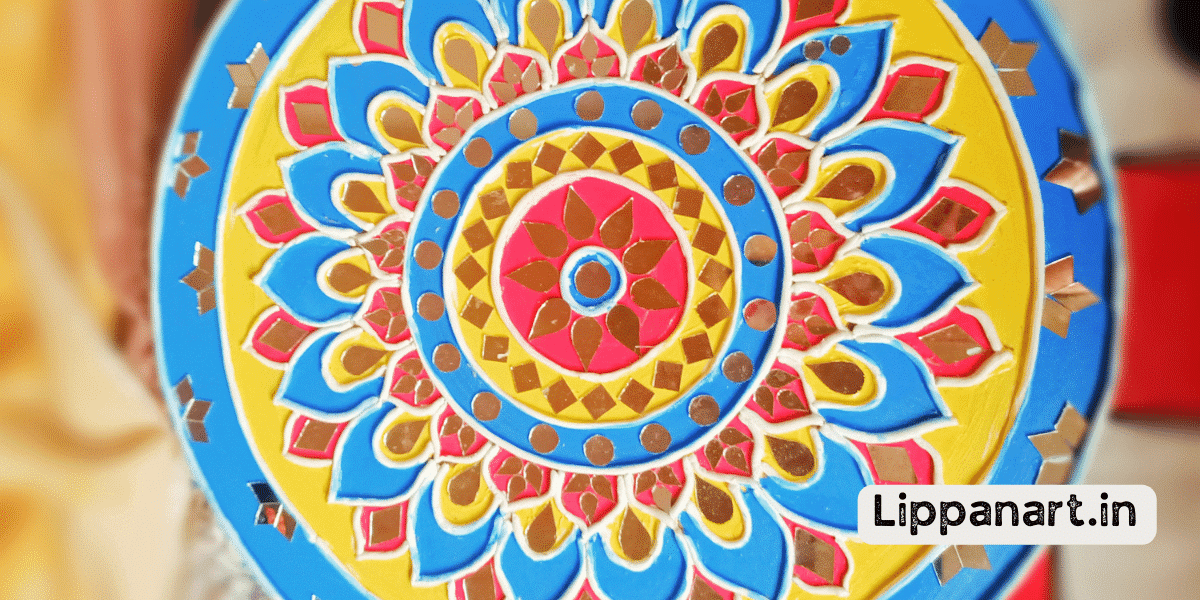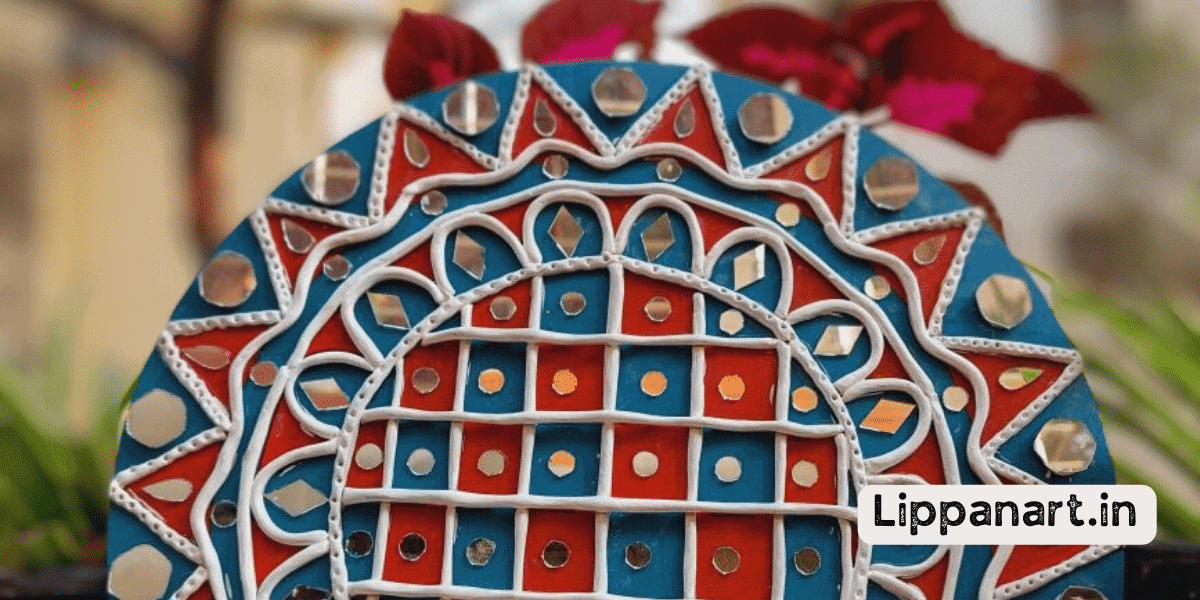Gently crafted and full of meaning, religious lippan art is a beautiful representation of culture and faith. Take a journey with us as we explore the importance and beauty of this traditional art form, from its humble origins to its modern-day uses.
Uncover this ancient craft’s spiritual and cultural significance and appreciate the stories it tells.
Let us inspire you to appreciate and preserve this timeless art form.
Key Takeaways
- Religious Lippan Art is an intricate form of folk art that originated in Gujarat, India and is used to decorate Hindu temples.
- The art form represents the transition between phases of life and traditional gender roles, rooted in ancient Gujarati culture and the Hindu Caste System.
- The materials used in Religious Lippan Art include mirrors, coloured glass, clay, combs, needles, and colourful fabrics, each chosen for its symbolism and spiritual messages.
- The art holds cultural, tribal, and spiritual significance, promoting intercultural dialogue, strengthening family and tribe bonds, and conveying prosperity, abundance, and ancient stories.
What Is Religious Lippan Art
You’ve probably heard of religious Lippan art, but do you know what it is and why it’s important?
Religious Lippan art is an intricate form of folk art that originated in the Indian state of Gujarat. It’s made by creating a mosaic pattern from small pieces of mirror, coloured glass, and clay affixed onto a wall or floor. The art form is commonly used to decorate the entrances of Hindu temples and is thought to elevate the status of the deity to which it is dedicated.
Religious Lippan art is also used as a form of artistic expression, with each piece offering its unique interpretation of the subject. It’s believed to represent the transition between different phases of life and to celebrate traditional gender roles. Furthermore, the art has a strong contemporary relevance and is often used to decorate the walls of modern homes and businesses.
The importance of religious Lippan art is further amplified by its use in public ceremonies and festivals. It’s often used to decorate traditional wedding venues and mark special occasions such as important religious festivals. The intricate designs and colourful patterns are thought to bring good luck and prosperity to the devotee who wears them.
History and Origin of Religious Lippan Art
Frequently, religious Lippan art has its roots in ancient Gujarati culture and traditions. This tradition is based on the Hindu Caste System, which dictates the beliefs and values of the people. It is a highly structured art form involving intricate designs and patterns, usually created with mud and mirrors. The patterns can represent various aspects of Hindu culture, such as gender roles, power dynamics, and social hierarchy.
The art form originated in the late 16th century to decorate homes and temples. The designs were used to bring positivity and protection to the home or temple. Over time, the designs became increasingly complex, becoming a popular art form among the upper classes.
| Caste System | Gender Roles |
|---|---|
| Historically, the Caste System determined one’s social status and occupation. | In the Hindu Caste System, gender roles were strictly enforced. |
| It was used to create a social hierarchy among the people. | Women were expected to stay home, and men were allowed to work outside. |
| It was based on one’s birth and could not be changed. | This was reflected in the art, where the roles of men and women were often depicted. |
| The Caste System is still present in Indian society today. |
The art form has been used to express the people’s beliefs and values and depict the historical context of the time. Its use has been passed down through generations and has become a popular form of art in India today. Overall, religious Lippan art is an important part of Indian culture, used to express beliefs, values, and historical context.

Materials Used in Religious Lippan Art
You’ll often find Religious Lippan art made with mud and mirrors. The art is an ancient Indian folk art tradition that uses mud and mirrors to create intricate designs and colourful symbols. This art form is used to convey spiritual messages and is often used during ceremonies and rituals.
Here are some materials commonly used in Religious Lippan art:
- Colourful fabrics: Colorful fabrics are used to create intricate designs and symbolism techniques.
- Mud: Mud is used to create the base of the art piece and is mixed with different ingredients to give it texture and design.
- Mirrors: Mirrors create reflective surfaces and add sparkle and depth to the art.
- Tools: Various tools such as combs, sticks, and needles are used to create intricate designs and shading.
The materials used in Religious Lippan art are carefully chosen for their colour symbolism, spiritual messages, and art techniques. Each material has an important role to play in the creation of this beautiful art form. The art is created with an eye for detail and a passion for the spiritual messages it conveys.
It’s a unique art form that’s deeply rooted in Indian culture.
Cultural Significance of Religious Lippan Art
By combining colourful materials and reflective surfaces, you can create an art piece that conveys spiritual messages and reflects Indian culture – a unique Religious Lippan art form. This art form is aesthetically pleasing and has a deep cultural significance. Conservation awareness, gender practices, intercultural dialogue, oral histories, and popular narratives are all integral to the meaning behind Religious Lippan art.
The most interesting aspect of this art form is its ability to reflect popular narratives using symbols. For example, the use of cows, frogs and other animals in artwork could be a symbol of prosperity and abundance. These symbols are often used to celebrate important occasions and tell ancient stories. Moreover, using colours and shapes often represents gender practices and cultural norms.
| Conservation awareness | Gender practices | Intercultural dialogue |
|---|---|---|
| Oral histories | Popular narratives | Bright colours & shapes |
Furthermore, Religious Lippan art is a form of intercultural dialogue, allowing different communities to share their beliefs and values. It is also a way to spread awareness about the conservation of nature. Art is seen as a living form of art, as it constantly changes and evolves. As such, it is important to preserve its history and legacy.
Traditional Uses of Religious Lippan Art
Have you ever heard of Lippan Art? It’s a traditional form of art found in some parts of India.
It’s used for various ritual practices and cultural expression and is significant in folklore.
Let’s take a look at how it’s traditionally used.
- Editor’s Choice
- Best Seller
- Amazon Choice
Folklore Significance
You marvellously appreciate the rich folklore significance of religious Lippan art, which has been used for centuries in traditional ceremonies. It’s an art form full of symbolism and meaning, used to express ceremonial rituals, tribe connections, gender roles, spiritual beliefs, and healing arts.
Here are four ways religious Lippan art is culturally significant:
- It serves a ceremonial purpose, used to create an environment of prayer and contemplation.
- It helps to strengthen the bond between families and tribes.
- It reinforces gender roles and spiritual beliefs.
- It’s used in the healing arts to promote physical, mental, and emotional well-being.
Religious Lippan art is important to the region’s cultural heritage and should be preserved and shared with future generations.
Ritual Practices
Amazingly, religious Lippan art has been used traditionally in ritual practices for centuries. Making offerings, healing rituals, connecting gods and seeking blessings, and visible prayers all come to life through this art form. It’s a way to bring prayer and worship to life, often through colourful and intricate designs. These designs are made from mirrors, glass beads, and shells, all believed to bring divine energy into the ritual.
The ceremonial purpose of the art is to create a physical connection between the worshiper and the gods. It’s a link to the spirit world and a way to ask for blessings, healing, and protection. By creating a physical object visible to all, people can connect with their gods and ask for help. It’s also believed to bring luck, prosperity, and protection to the family.
The art and ritualistic practices are an integral part of the religious culture and are still practised today. It’s a way to honour the gods and seek their divine guidance. It’s also a way to bring peace and joy to the family and community.
Religious Lippan art is a powerful reminder of the importance of ritual practices in spiritual life.
Cultural Expression
Have you ever wondered how religious Lippan art is used to express culture and tradition? This art form is unique in its use of religious symbolism, gender roles, artistry techniques, and social dynamics to create beautiful and meaningful pieces. Here are four ways Lippan art has impacted cultural expression:
- Religious Symbolism: Lippan art often includes religious symbols and stories representing the values and beliefs of the community.
- Gender Roles: Lippan art has long been used to express gender roles, such as female fertility.
- Artistry Techniques: Different techniques are used to create the intricate designs of Lippan art, such as intricate mirror work and embroidery.
- Social Dynamics: The production and sale of Lippan art have impacted the region’s social dynamics and market trends.
As you can see, religious Lippan art plays an important role in the community’s cultural expression. Through its symbols, gender roles, artistry techniques, and social dynamics, it helps preserve and communicate culture and tradition creatively and meaningfully.

Religious and Spiritual Significance
Though you may not realise it, religious Lippan art has a deep spiritual significance that can bring great peace and joy to those who appreciate it. Faithful devotion to religious belief systems is often expressed through art, reflecting a person’s religious heritage and spiritual beliefs. Lippan art is more than just an artistic expression; it’s a ritual practice that can bring comfort and solace to those who view it.
The intricate designs that can be found in Lippan art are often reflective of the spiritual beliefs of the artist. The patterns often represent prayers, blessings, or other spiritual symbols. The art can also be used as a form of meditation, allowing the artist to find inner peace and clarity.
The themes found in religious Lippan art often reflect devotion to a certain deity or spiritual path. The artist may use a variety of symbols to express their beliefs, such as mandalas, animals, plants, and flowers. All these symbols are used to convey a deeper spiritual meaning.
The use of colour in religious Lippan art is also significant. Different colours are often associated with different deities or spiritual practices, so the artist may choose colours that reflect the beliefs of the artist.
Religious Lippan art is a meaningful expression of faith and devotion. Appreciating it can bring comfort and solace to those who seek it. The intricate designs and symbols can be used to meditate and reflect on one’s spiritual path. The art can also honour and express one’s religious beliefs while uniquely expressing faith and devotion.
Modern Uses of Religious Lippan Art
You can find modern uses of religious Lippan art in many places, from home decor to spiritual retreats. In recent years, this art form has grown in popularity, emphasising eco-friendly production, the impact of tourism, and the artist spotlight. Here are four interesting ways religious Lippan art is used in modern society:
- Gender Roles: This art form often highlights the importance of gender roles in Indian societies and their impact on family relationships.
- Home Decor: Many people use religious Lippan art to decorate their homes, creating an atmosphere of spiritual peace and relaxation.
- Social Media: Social media is a great platform to share religious Lippan art and its spiritual significance.
- Retreats: In recent years, religious retreats have focused on Lippan art to connect to one’s spirituality and inner peace.
Appreciation and Preservation of Religious Lippan Art
You can appreciate and preserve religious Lippan art by understanding its cultural and spiritual significance. Revitalisation efforts, such as ethical production and economic benefits, are key to its preservation. To ensure the sustainability of the art form, community engagement is essential.
Art therapy also plays an important role in promoting the art form. Engaging in the activity can help to lower stress levels, enhance one’s self-worth, and facilitate the process of recovery. By engaging in art therapy, people can learn more about the significance of the art form.
Additionally, efforts to raise awareness about the art form and its importance locally and globally will help ensure its preservation. By teaching people about the art form’s history, symbolism, and artistry, they can become more invested in its preservation. This, in turn, will lead to more support for initiatives to revitalise the art form.
Supporting local artisans and encouraging ethical production can also ensure the preservation of religious Lippan art.
Conclusion
Religious Lippan art has been a part of Indian culture for centuries, and its importance shouldn’t be underestimated. Its traditional uses, spiritual significance, and cultural values should be appreciated and preserved.
Its intricate beauty is a sight to behold, and it can transport you to a different world with its allusions and imagery. It’s truly a work of art; everyone should recognise its importance.











